最新世界经济学课件
- 格式:doc
- 大小:436.00 KB
- 文档页数:46
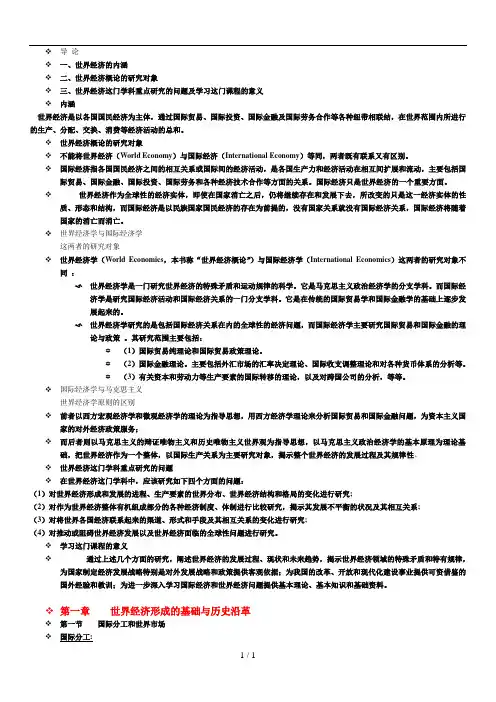
❖导论❖一、世界经济的内涵❖二、世界经济概论的研究对象❖三、世界经济这门学科重点研究的问题及学习这门课程的意义❖内涵世界经济是以各国国民经济为主体,通过国际贸易、国际投资、国际金融及国际劳务合作等各种纽带相联结,在世界范围内所进行的生产、分配、交换、消费等经济活动的总和。
❖世界经济概论的研究对象❖不能将世界经济(World Economy)与国际经济(International Economy)等同,两者既有联系又有区别。
❖国际经济指各国国民经济之间的相互关系或国际间的经济活动,是各国生产力和经济活动在相互间扩展和流动,主要包括国际贸易、国际金融、国际投资、国际劳务和各种经济技术合作等方面的关系。
国际经济只是世界经济的一个重要方面。
❖世界经济作为全球性的经济实体,即使在国家消亡之后,仍将继续存在和发展下去,所改变的只是这一经济实体的性质、形态和结构,而国际经济是以民族国家国民经济的存在为前提的,没有国家关系就没有国际经济关系,国际经济将随着国家的消亡而消亡。
❖世界经济学与国际经济学这两者的研究对象❖世界经济学(World Economics,本书称“世界经济概论”)与国际经济学(International Economics)这两者的研究对象不同:世界经济学是一门研究世界经济的特殊矛盾和运动规律的科学。
它是马克思主义政治经济学的分支学科。
而国际经济学是研究国际经济活动和国际经济关系的一门分支学科。
它是在传统的国际贸易学和国际金融学的基础上逐步发展起来的。
世界经济学研究的是包括国际经济关系在内的全球性的经济问题,而国际经济学主要研究国际贸易和国际金融的理论与政策。
其研究范围主要包括:✡(1)国际贸易纯理论和国际贸易政策理论。
✡(2)国际金融理论。
主要包括外汇市场的汇率决定理论、国际收支调整理论和对各种货币体系的分析等。
✡(3)有关资本和劳动力等生产要素的国际转移的理论,以及对跨国公司的分析,等等。
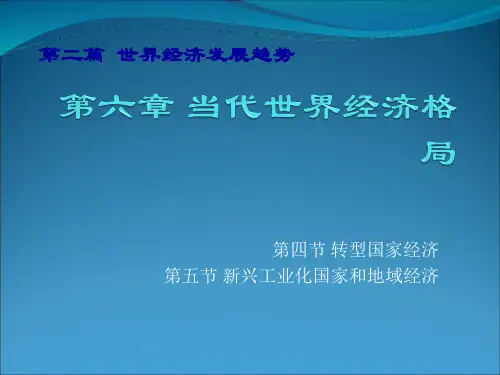
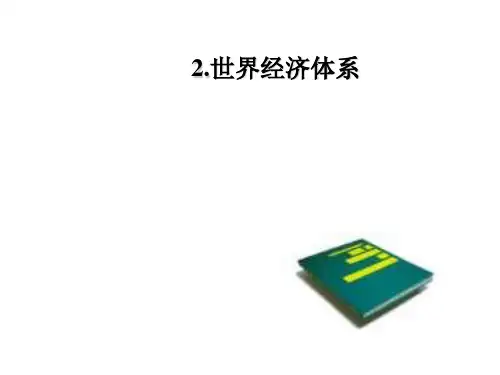
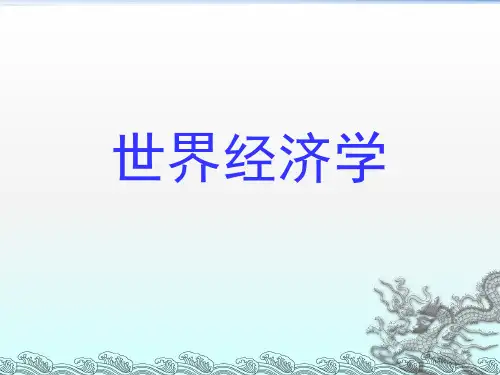
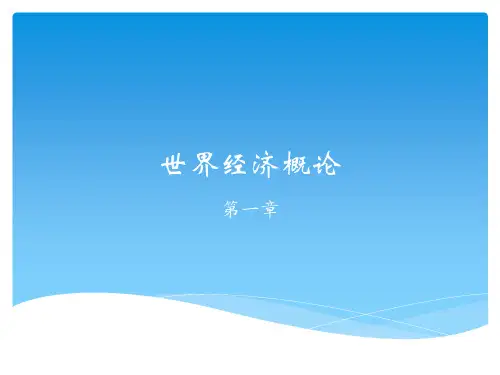

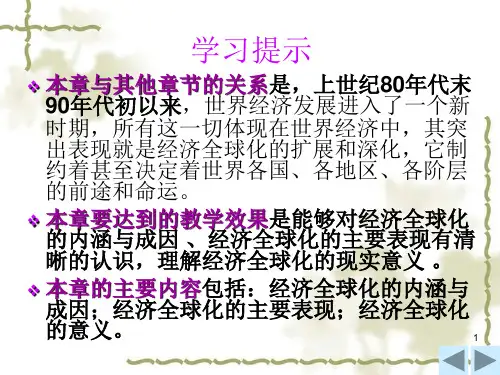
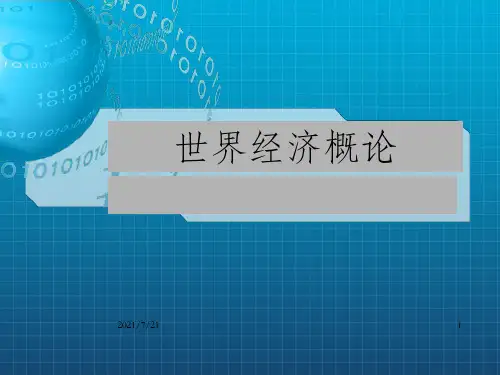
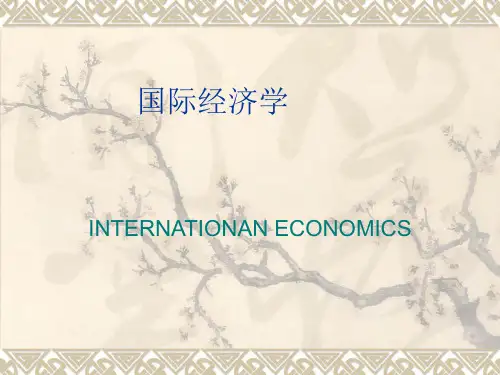
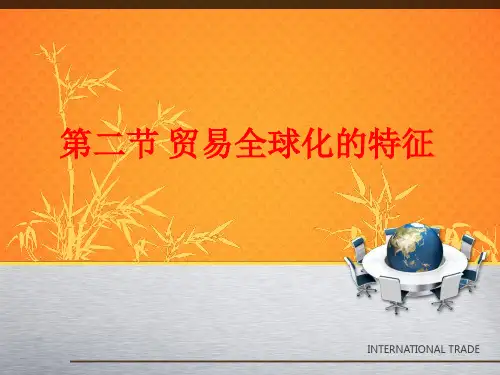
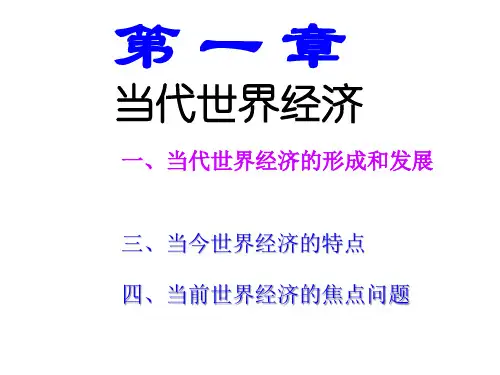
世界经济学课件A SURVEY OF WORLD ECONOMYIntroductionWhat is WORLD ECONOMY?WORLD ECONOMY refers to the entirety of all the national economies which are linked together with different economic links.What is WORLD ECONOMICS?WORLD ECONOMICS is a branch of ECONOMICS which studies the WORLD ECONOMY.The start of the study:at the end of 1970sIn 1980---China World Economy AcademyThe source of this branch of study:a branch --- Economicsbackground and necessary conditions : International division of labour →international trade → the world market → the world economy.The objects of the branch of study: the international relations of production.1. to study the national economies of the countries in the world, which are parts of the world economy2. to study the international economic relations.mechanism links the national economies togetherdifferent economic linksinternational division of labourgoodsservicecapitaltransfer of technology.3. to study the world economy as a whole.the laws of the changes and development of the world economyworld economy studies the system of economic developmenthuman beings--- the principal part of the systemthe environment and the resources of the earth --- the base for the systemChapter OneProductive Forces and the World Economy1.the development of productive forces : the scientific and technological revolutionsin the history of human beings; the significance and impact of the revolutions2.the formation and development of the world economy as a result of the scientificand technological revolutionsbibliography:1.Basic Economics, Hailstones & Mastrianna, 9th edition, South-Western Publishing Co. ,Cincinnati, Ohio, 19922.Economics Today, roger Leroy Miller, 9th edition, Adisson-Wesley Education EducationalPublishes Inc., 19973.《世界经济学》张伯里主编中共中央党校出版社 2004年7月第1版4.《当代世界经济》王广信赵丽娜主编人民出版社 2002年3月第1版5.《世界经济新论》庄起善主编复旦大学出版社2004年8月第1版6.《世界经济概论》池元吉主编高等教育出版社2003年8月第1版I. the development of the Productive Forces and the Formation of the World Economy1. the influence of the Renaissance and of the Dicovery of the new continentthe primitive economic system--- low productive forces--- no world economy Renaissance liberated peoplethe beginning of the Renaissance---Dante’s Commedia (14th century) Renaissance: the intermediate between the Middle Ages and the modern times;the beginning of capitalist cultural ideasthe product of the new, rising capitalist relations of productionideological feature: humanism,the enlightenment: in 18th centuryIn 1492, Columbus discovered the new continent.the new sea routeEuropean ports ---international trade centres: London, Antwerp, Lisbona solid base for the big jump of the economy.2. the impact of the first scientific and technological revolution on the world ecnomyIn 18th century, the first scientific and technological revolutionsteam engine --- work continuouslymachine makes machinesmore products for the marketsteam boat and steam engine train --- revolution in the transport industrythe capitalist mode of productionIndustry was totally separated from farming.object of the capitalist mode of production: profit-pursuingmarkets--- raw materialsthe world market--- the world economy3. the impact of the second scientific and technological revolution on the world ecnomyTime: in the 19th centuyGermany and the United States : the heroesElectricity : a new kind of powerOther things: radio,cable, telephone, internal combustion engine, new skills for steel-making, new technology in chemical industry → heavy industryautomile industry --- the oil industryThe second scientific and technological revolution started in heavy industryIndustry →the most import section in the national economies.More industralized countriesimport raw materials and export finished productsfarming countries export agricultural products and other raw materials, import industry goodsthe international division of labour developed furtherScience and technology acted and reacted on each other.the study on the basic theories and the scientific research worknew inventions: new communication methods, big steel-made boat, cars and trucks, and even airplanetransport(more quick, safe, convenient and cheep) →international exchange of goods →the world market →the system of the international division of labour → more efficient production →the world market (for raw materials and finished goods )→ closer relation of the countries tied together by the world market4. the formation and development of the world economya)The development and formation of the world economy was a result of thescientific and technological revolutionsb)The system of international division of labourThe economic ties between the suzerain states and its colonies or between theadvanced industry countries and the countries producing raw materials became more strengthened. a world market formed.c)the industry capital --- the banking capital →financial capital → financialoligarch →the export of capitald)the international monetary system establisheda world currency or currenciesgold and silver acted as the world currenciesthe gold standard was establishedThe gold standard had 3 featuresFirst: It establishd a system of fixed exchange rate between participating countries. Stable exchange rates were considered a necessary ingredient to increase trade among nations. Second: the gold standard limited the rate of growth in a country’s money supply. This was due to the fact that all “money” had to be backed by gold, and the supply of gold in the world increased slowly during this period of time in history.Third: Gold served as an automatic adjustment tool for countries experiencing balance ofpayments problems. If a country was running a balance of payments deficit, gold would, by market forces, flow out of the country, decreasing economic activity and pushing the balance of payments back toward balance.Conclusion:division of labour →rise of productive forces →efficieny of the prodution →frequency of exhange of goods →the early system of the capitalist international division of labour ---the first scientific and technological revolution→ the world market, the world currency, the system of the capitalist international division of labour →the beginning of world economythe second scientific and technological revolution→the improvement of the system of the capitalist international division of labour (early stage of internationalization of production) →the world market →(barriers to trade and surplus of capital →the export of capital) →international monetary system→world economyThen the world economy finally established.Three steps for world economy: goods (international) (or the internationalization of goods)→capital(international) (or the internationalization of capitals) →production(international, after the 3rd scientific and technological revolution) (or the internationalization of production)II. the third scientific and technological revolution caused great improvement in productive forces1.The factors which caused the third scientific and technological revolutiona.the development of science and technologyb.the motivation of capital for profitsc.the government’s support for the scientific researchd.cold war made the west and the east compete for the military equipments2. the impact of third scientific and technological revolutiontime: started at the end of 1940splace: from the US --- the former Soviet Union, Japan, and the west Europe and then the other countries.Peak: at the end of 1960s.symbols : nuclear power, computer and space technologyNew power,new materials and electronic technology made the third revolution much more remarkable than the first two ones.nuclear power --- the shortage of energy and resources --- supports quicker development of the science, technology and the production.Man-made new materialscomplex materials --- in the aviation or space technology, now even in car industry.Plastic--- used in many placesComputer totally changes our life.computer to operate machinethe improvement of the international division of labour --- the vertical one and the horizontal onethe specialisation of the multinational corporations (MNCs)the global operative strategies : the international arrangement for the R&D projects,production and marketing, the flow of capital and so on.the reproduction cycle →international : production→ distrbution →exchange and consume --- internationalthe factors of production → international: capital, technology, raw materials and labour →international.The internationalization of production may push the productive forces to rise to a new level.the third scientific and technological revolution→the (mature) system of the capitalist international division of labour (internationalization of production) →the world market →world economyNow the world economy becomes so important that almost every country is involved in it and has its own roles in it. Of course, some countries have more important roles in it. Others may have less important roles in it.III. the intenerating of the capitalist industry structurethe reproduction cycle --- the comparative decreasing input ---the comparative increasing inputlabour-intensive and resources-intensive industries →knowledge-intensive and technology-intensive industries.There are two kinds of intenerating of the industry:1.Intensive intenerating : within one industry, the input of manual labour decreases, but theinput for R&D, information service and so on increase.2.Extensive intenerating : sections which may provide other sections with services ofinformation and knowledge appear to be more important.IV. the trends and laws of the scientific and technological revolution.1.the trends:the changes become quicker and quickerthe result of the changes provides a base for a new revolution.2.the laws:1)the progress of science and technology becomes quickere.g. steam engine: from research to putting into production--- 100 yearstelephone---56 yearsradio---35 yearsairplane---14 yearstelevision---12 yearstransistor--- 5 yearssolar cell--- 2 years2)the leading industries:The time for the exchange of the leading industries becomes shorter.3)the change of scientific structure:Scientific structure:a)people (their number, their age, and their level)b)their specialization (the basic theory, applying theory, natural science, social science,hardware, and software etc. )c)the lab and the equipments and so ond)the information resources and education levelThe scientific structure is always in a dynamic state.Questions:1.How do you underst and “the world economy”?2.How the world economy was formed?3.Please illustrate the impact of the first and the second scientific and technologicalrevolution on the formation of the world economy.4.Please illustrate the impact of the third scientific and technological revolution on theworld economy.5.How the third scientific and technological revolution promoted the globalization of theeconomy?Chapter TwoThe Productive Forces and the cycle of the world economy1.business cycle2.the economic cycles of the world economy after the World War II the features ofthe cycles3.the new economy and the cyclebibliography:1.Basic Economics, Hailstones & Mastrianna, 9th edition, South-Western Publishing Co. ,Cincinnati, Ohio, 19922.Economics Today, roger Leroy Miller, 9th edition, Adisson-Wesley Education EducationalPublishes Inc., 19973.Economics, N.Gregory Mankiw, 3rd edition, Tsinghua University Press 20064.《世界经济学》张伯里主编中共中央党校出版社 2004年7月第1版5.《当代世界经济》王广信赵丽娜主编人民出版社 2002年3月第1版6.《世界经济新论》庄起善主编复旦大学出版社2004年8月第1版7.《世界经济概论》池元吉主编高等教育出版社2003年8月第1版1.business cyclebasic problem for the capitalism--- the development of industry is always interrupted by periodic economic crisis. This makes the economic growth in the capitalist countries unstable.striking feature --- instability, fluctuationsBusiness cycle: the rise and fall of economic activity relative to the economy’s long-term growth trend. As the cycle progresses, all parts of the economy display marked changes in activity as they move through distinctive periods usually called trough, expansion, peak, and contraction. Production, prices, income, and employment activities all show characteristic changes during the cycle; in fact, no part of the economy is free from this cycle. Extensive studies have shown thatthese cyclical fluctuations are found in economies throughout the world.1. Real or physical causes :❖Innovation Theory: the theory that business cycles are caused by breakthroughs in the form of new products, new methods, new machines, ornew techniques.❖Agricultural Theories: theories of the business cycle that relate the general level of business activity to the weather.2. psychological causes:❖Psychological Theory: the theory that when investors and consumers react according to some belief about future conditions, their actions tend totransform their outlook into reality.Rational Expectations Theory: an economic theory suggesting that individuals and business act or react according to what they think is going to happen in the future after considering all available information.3. monetary causes:Monetary Theories: theories that the business cycles is caused by the free and easy expansion of the money supply.4. spending and saving causes:Under-consumption Theories: theories that the business cycle is caused by the failure to spend all national income, resulting in unsold goods, reduced total production, and consequent reductions in employment and income.❖The economy does not distribute enough income among thefactors of production to permit purchase of all the goods andservices produced by the economy.❖The economy does distribute enough purchasing power to buythe total goods and services produced but that not all theincome or purchasing power is used.Circular flow of income❖Is the cyclical operation of demand, production, income, and new demand.❖Income =demand →production →distribution (enough) (income)= new demand❖Income ≠spending ( less demand) →leakages❖Leakages are flows out of the circular flow that occur when factor income is received and not spent directly on purchases.❖Injections are added spending in the circular flow that are not paid for out of factor income.❖Underinvestment Theory: the theory that recessions occur because of inadequate investment in the economy.❖spending on consumption is less than total income❖ the difference must take the form of investmentPhases of the Cyclestwo phases: contraction 扩张 and expansion 收缩The top: peakThe lowest point: troughfour phases:prosperity 繁荣;recession 衰退, 不景气;depression 萧条;recovery 复苏recession: GDP ↓continuously for two quarter (demand, investment, employment, production output, profit, even stock price and interest rate ↓)depression: long and continuous recession spreadA peak exists whenever an overall high level of economic activity prevail.A contraction occurs whenever the level of business activity drops noticeably.The trough is the period when the level of business activity has dropped as far as it is going to drop in a particular cycle.Expansion occurs when the level of business activity begins to rise.Trough: low income →low demand →price down →profit low (in spite of low cost ) →employment low → levels of investment low → interest rate downIndustries: less need to replace worn-out capitalConsumers : less need for durable goodsExpansion:Production increase →employment and income increase →demand increase →price rise (but cost rise slower) → profit rise → levels of investment increase → interest rate rise slowly →expansion is on its way to peakPeak:A peak generally has favorable social and political consequences as well as a good economic effect on society e.g. high-level prosperity.Contraction: As production increase, the economy eventually reaches the bottleneck stage. Downswings are certain to occur.Pattern of cycles:contraction → trough → expansion → peak → contractionOnce a contraction has started, a cumulative action among several elements in the economy tends to augment the downswing. During the trough, however, other forces eventually arrest the contraction and start an upward movement. Once this upward motion begins, reactions of individuals and businesses tend to augment the expansion. During the peak, however, forces build up that eventually cause a new contraction.four forces or types of economic change affect the level of business activity:(1)the trend,(2)seasonal variations,(3)random fluctuations,(4)cyclical fluctuations.The trend is the directional movement of the economy over an extended period of time, such as 20 to 30 years.Seasonal variations are recurring fluctuations in business activity over a given period, usually 1 year. The cause of the fluctuations may be natural and artificial.Random fluctuations in business activity resulted from unexpected or unusual events. A serious flood or drought can affect certain portions of the economy or even the economy as a whole. Cyclical fluctuations are changes in the level of business activity that come about regardless of the trend, seasonal variations, or random forces.internal forces of business cycles: are elements within the very sphere of business activity itself and include such things as production, income, demand, credit, interest rates, and inventories. external forces of business cycles: are elements outside the normal scope of business activity and include population growth, wars, basic changes in the nation’s currency, and national economic policies, as well as floods, droughts, and other catastrophes (disasters) that have a pronounced effect on business activity.Types of business cyclethe Kitchin inventory cycle (3–5 years) — after Joseph Kitchin(约瑟夫.基钦)In 1923---article :"Review of Economic Statistics"---outlining his discovery of a 40-month cycle resulting from a study of U.S. and UK statistics from 1890 to 1922--- based on a stocking /destocking cycleInventory--- production---economythe early phases of a contraction---- inventories: rather high levelretailers supply goods out of inventory and cut orders from producersproduction--- low leveltrough--- inventories depletedcompanies --- replace inventoriesmost current sales --- ordering goods from the producerproduction increases to stimulate the economy to expandsales increase---the size of inventories increasesproduction increase --- greater demand by consumers + build up inventoriesprice increases are anticipated--- firms build up inventories and increase the ratio of inventory to sales--- increase in production (beyond the actual consumer demand)the reverse situation--- contractionthe Juglar fixed investment cycle (7–11 years) — after Clement Juglar(朱格拉)business cycle --- recovery and prosperity are associated with increases in productivity, consumer confidence, aggregate demand, and prices.The French economist identified four phases to each wave: prosperity, crisis, liquidation and recessionthe Kuznets infrastructural investment cycle (15–25 years)— after Simon Kuznets (库兹涅茨), Nobel LaureateRussian-born American economist who carried out research on the U.S. real-estate cycle. analyzed and quantified the cyclical nature of production and prices in spans of fifteen to twenty yearsThe Kondratiev wave or cycle (45–60 years) (grand supercycles)— after Nikolai Kondratiev (尼古拉·康德拉季耶夫)cycles of boom followed by depressionvisible in international production data than in individual national economiesconcerns output rather than pricesKondratiev wave --- two 'seasons': the Kondratiev Fall--- and the Kondratiev Wintera bull market is associated with 'fall' and a bear market with ‘winter’the Forrester cycles (200 years) - after Jay Wright Forrester.the Toffler civilization cycles (1000-2000 years) - after Alvin Toffler.Joseph Alois Schumpeter (约瑟夫·阿洛伊斯·熊彼特) suggested a model in which the four main cycles, Kondratiev(54 years), Kuznets (18 years), Juglar (9 years) and Kitchin (about 4 years) can be added together to form a composite waveform.A Kondratiev wave could consist of three lower degree Kuznets waves. Each Kuznets wave could, itself, be made up of two Juglar waves. Two (or three) Kitchin waves could form a higher degree Juglar wave.the four waves can be added together to form a composite waveformActually there was considerable professional rivalry between Schumpeter and Kuznets. The wave form suggested above might not include the Kuznets Cycle simply because Schumpeter did not recognize it as a valid cycle.2. the economic cycles of the world economy after the World War IIfive economic crisis since the end of World War II,(1) the first economic crisis: 1957---1958 started from the US in April 1957 and soon spread to Canada, countries in west Europe and Japan. It lasted for about one year.remarkable features: at the same time; the prices did not fall but rise.(2) the second economic crisis: 1973-1975The first “oil shock” occurred in the last quarter of 1973.a good example for an aggregate supply shock → a world economic crisis(any unanticipated shift in aggregate demand or supply are called aggregate demand shocks or aggregate supply shocks) .features for this crisis:a)it lasted a long time and the production fell down dramatically: 22 months for UK, 15months for Japan, 14 months for west Germany and 9 months for France and America.The industrial production decreased by 15.4% in the US, 11.2% in UK, 16.3% in France.b)bankruptcy and unemployment: about 120 thousand large firms with property more than1 million US dollars went bankrupt. The number for jobless people even reached 18.5million.c)the stock market fell drastically. (stock price index ↓76%~32%) Investment ↓20%,180 banks went bankrupt in America,d)serious inflation → stagflationtrade protection → decrease of the international trade(3) The third economic crisis: 1979~1982features:a)stagflation;b) a long time and had an intricate progress:c)bankruptcy and unemployment reached the highest record. e.g. in 1981, firms wentbankrupt: in Britain: 14,000; in France: 20,900; in west Germany: 8,500; in 1982,in the US 25,000 firms went bankrupt. At the end of 1982, the US and EC had 120million people out of work.d)the developing countries were hurt terribly.(4) The fourth economic crisis: 1990~1993features: a short crisis in America . a long time for the crisis in the world.(5) The fifth economic crisis: 2001~2002 imports of the US decreased continuously from the first quarter of 2001, which impacted on the exports of EU and JapanMost remarkable features about the economic crises after the Second World Wara)mild crises:b)Stagflationc)No very serious monetary credit crisismild crises: in 1929, industrial production↓46.2% in the US, ↓32.3% in UK, ↓32.9% in France.In 1973~1975, the industrial production↓15.4% in the US, ↓11.2% in UK, ↓16.3% in France.reasons for such a result: modern monetary, fiscal, and other measuresautomatic stabilizersmodern scientific technologyAutomatic, or built-in, stabilizers (in US): Special provisions of the tax law that cause changes in the economy without the action of Congress and the president. In other words, automatic stabilizers counter ups and downs in fiscal activity without the necessity for legislative action. Eg: the progressive income tax system , Social Security system : unemployment compensation and pension for old people.the progressive income tax system: in US, maximum rate: 40%.For an individual, as taxable income rises, the marginal tax rate rises, and as taxable income falls, so does the marginal tax rate. The average tax rate falls when less is earned. Unemployment Compensation:unemployment compensation stabilizes aggregate demand. Stabilizing Impact: The key stabilizing impact of the progressive income tax and unemployment compensation is their ability to mitigate changes in disposable income, consumption, and the equilibrium level of national income.the “visible hand”---the intervention of the government.Fiscal policy: is defined as the discretionary change in government expenditures and /or taxes in order to achieve such national economic goals as high employment or reduced inflation.(National goals may be: high employment, price stability, economic growth, and improvement in the nation’s international payments balance)Time lags tend to reduce the effectiveness of fiscal policy.Time lags includes the recognition time lag (a lag between the start of a recession and the availability of relevant data), the action time lag ( a lag between the recognition of a need for a fiscal policy and putting one in motion), and the effect time lag (a lag between policy implementation and tangible results).the recognition time lag + the action time lag = the inside lag (this is how long it takes to get a policy from inside the institutional structure of the federal government.)Fiscal policy has typically been associated with the economic theories of John Maynard Keynes and what is now called traditional Keynesian analysis.Kennedy-Johnson tax cut of 1964.In 1964, federally collected taxes were cut by $11 billion. From 1964 to 1965, the unemployment rate fell from 5.2% to 4.5%.Monetary policy: is defined as the discretionary change of the supply of money ( or the rate at which it grows ) in order to achieve national economic goals. Monetary policy works in a variety of ways to change the willingness of firms, individuals, governments and foreigners to buy domestically produced goods and services, both directly and indirectly.e.g. the Federal Reserve System (Fed) seeks to alter consumption, investment, and aggregate demand as a whole by altering the rate of growth of the money supply.The Fed uses three tools as part of its policymaking action: open market operations, discount rate changes, and reserve requirement changes.open market operations: the Fed changes the amount of reserves in the system by its purchases and sales of government bonds issued by the US Treasury. Fed’s open mar ket operation must cause a change in the price of bonds.discount rate changes: the discount rate is the interest rate the Fed charges depository institutions when they borrow reserves directly from Fed. An increase in the discount rate increases the cost of funds.reserve requirement changes: Fed rarely uses changes in reserve requirements as a form of monetary policyStagflation:Stagflation: sluggish economic growth coupled with a high rate of inflation. Because of the sluggish economic growth, unemployment is serious. However, at the same time, inflation exist. Remarkable feature for stagflation: the sluggish economic growth accompanied by the high rate of inflation and unemployment.Phillips curve does not workthe Phillips curve : a curve showing the relationship between unemployment and inflation.。